MGMT20144: Business Case Analysis of Oxfam Australia Report
VerifiedAdded on 2022/09/28
|10
|2207
|22
Report
AI Summary
This report provides a detailed business case analysis of Oxfam Australia, examining its structure, governance, and operational aspects. The analysis begins with a company synopsis, outlining Oxfam Australia's mission as a non-profit organization focused on long-term development projects and emergency responses. The report then delves into the business structure, highlighting the management team and organizational divisions, followed by the governance structure, emphasizing the role of the Board of Directors and its committees. Environmental factors impacting the company, such as infrastructure development and its consequences, are discussed. The report identifies key risks, including limited donations and market focus, and explores the business practices adopted by Oxfam Australia to achieve its goals. Finally, the functional departments, particularly the customer services department, are analyzed in terms of their role in the company's operations and customer relations. The report concludes with a summary of the findings, emphasizing the importance of governance, environmental awareness, and sustainable business practices for Oxfam Australia's continued success. This report is provided to the students on Desklib to assist them with their studies and to help them learn.
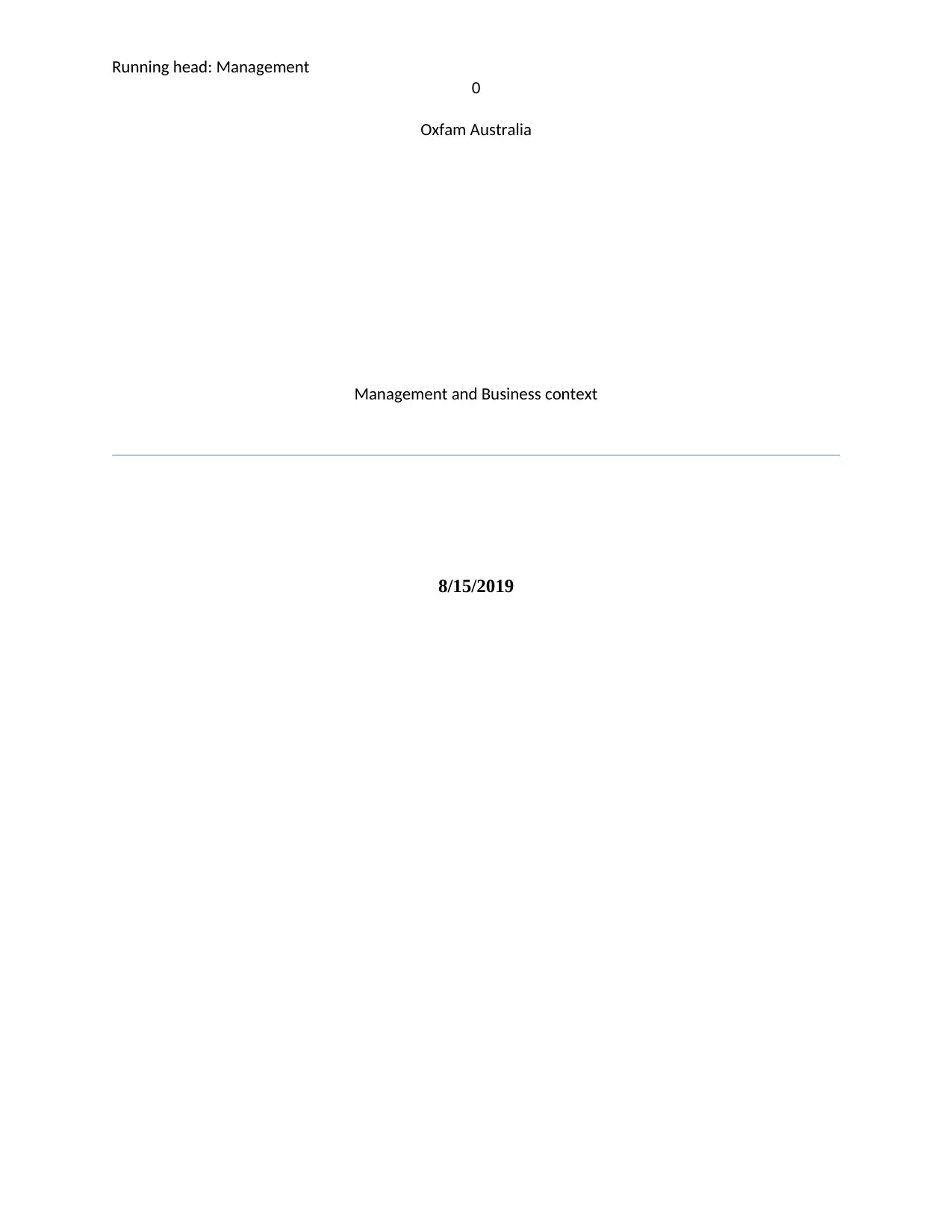
Running head: Management
0
Oxfam Australia
Management and Business context
8/15/2019
0
Oxfam Australia
Management and Business context
8/15/2019
Paraphrase This Document
Need a fresh take? Get an instant paraphrase of this document with our AI Paraphraser
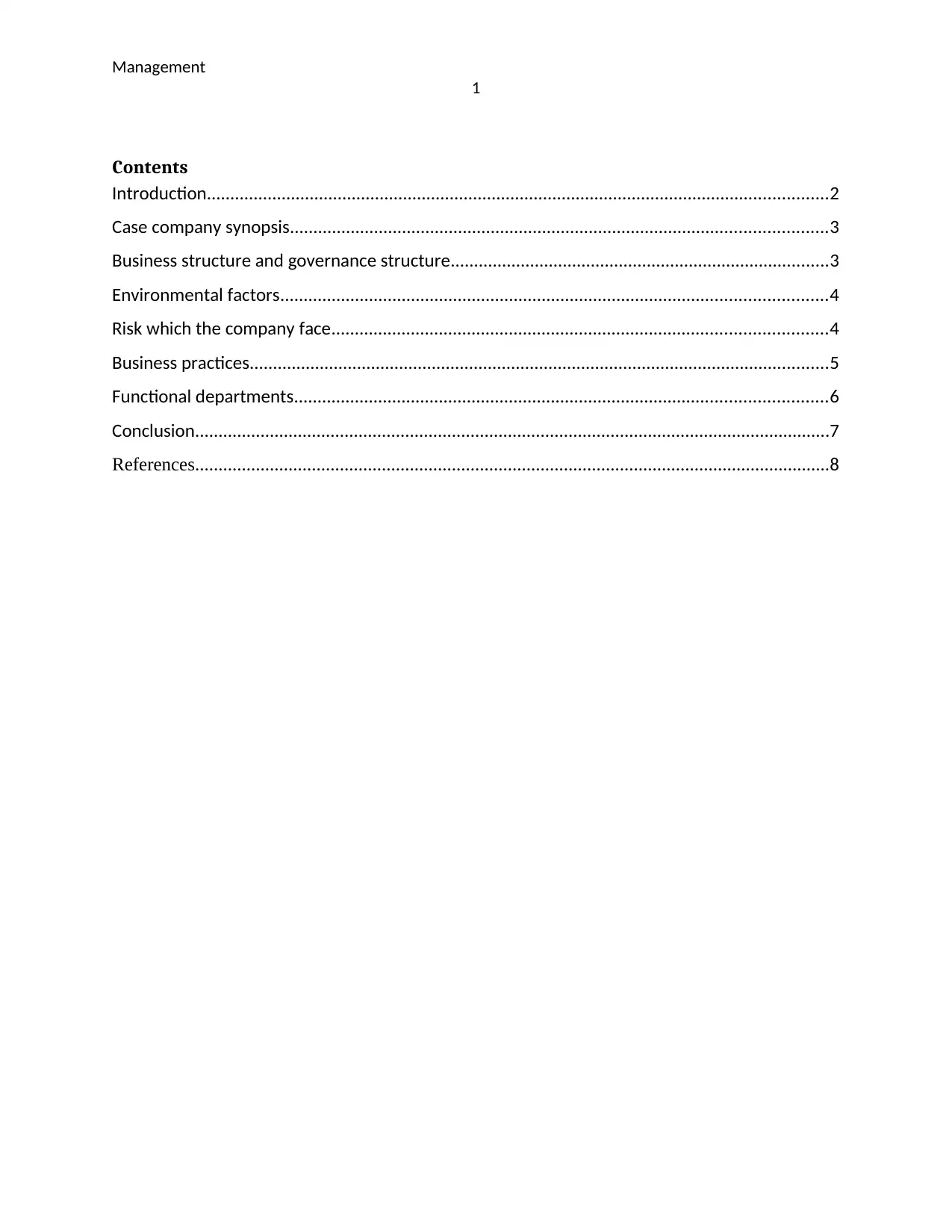
Management
1
Contents
Introduction.....................................................................................................................................2
Case company synopsis...................................................................................................................3
Business structure and governance structure.................................................................................3
Environmental factors.....................................................................................................................4
Risk which the company face..........................................................................................................4
Business practices............................................................................................................................5
Functional departments..................................................................................................................6
Conclusion........................................................................................................................................7
References........................................................................................................................................8
1
Contents
Introduction.....................................................................................................................................2
Case company synopsis...................................................................................................................3
Business structure and governance structure.................................................................................3
Environmental factors.....................................................................................................................4
Risk which the company face..........................................................................................................4
Business practices............................................................................................................................5
Functional departments..................................................................................................................6
Conclusion........................................................................................................................................7
References........................................................................................................................................8
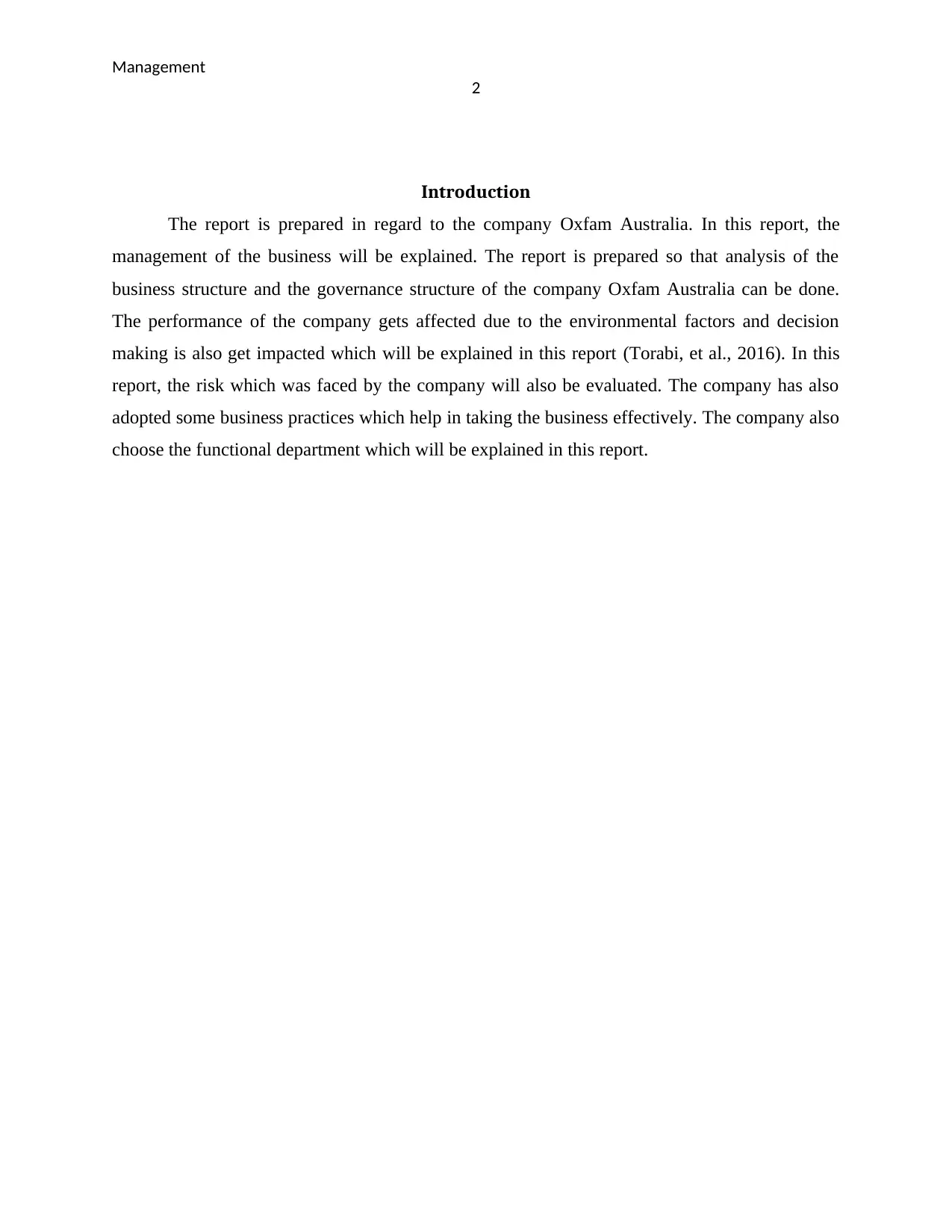
Management
2
Introduction
The report is prepared in regard to the company Oxfam Australia. In this report, the
management of the business will be explained. The report is prepared so that analysis of the
business structure and the governance structure of the company Oxfam Australia can be done.
The performance of the company gets affected due to the environmental factors and decision
making is also get impacted which will be explained in this report (Torabi, et al., 2016). In this
report, the risk which was faced by the company will also be evaluated. The company has also
adopted some business practices which help in taking the business effectively. The company also
choose the functional department which will be explained in this report.
2
Introduction
The report is prepared in regard to the company Oxfam Australia. In this report, the
management of the business will be explained. The report is prepared so that analysis of the
business structure and the governance structure of the company Oxfam Australia can be done.
The performance of the company gets affected due to the environmental factors and decision
making is also get impacted which will be explained in this report (Torabi, et al., 2016). In this
report, the risk which was faced by the company will also be evaluated. The company has also
adopted some business practices which help in taking the business effectively. The company also
choose the functional department which will be explained in this report.
⊘ This is a preview!⊘
Do you want full access?
Subscribe today to unlock all pages.

Trusted by 1+ million students worldwide
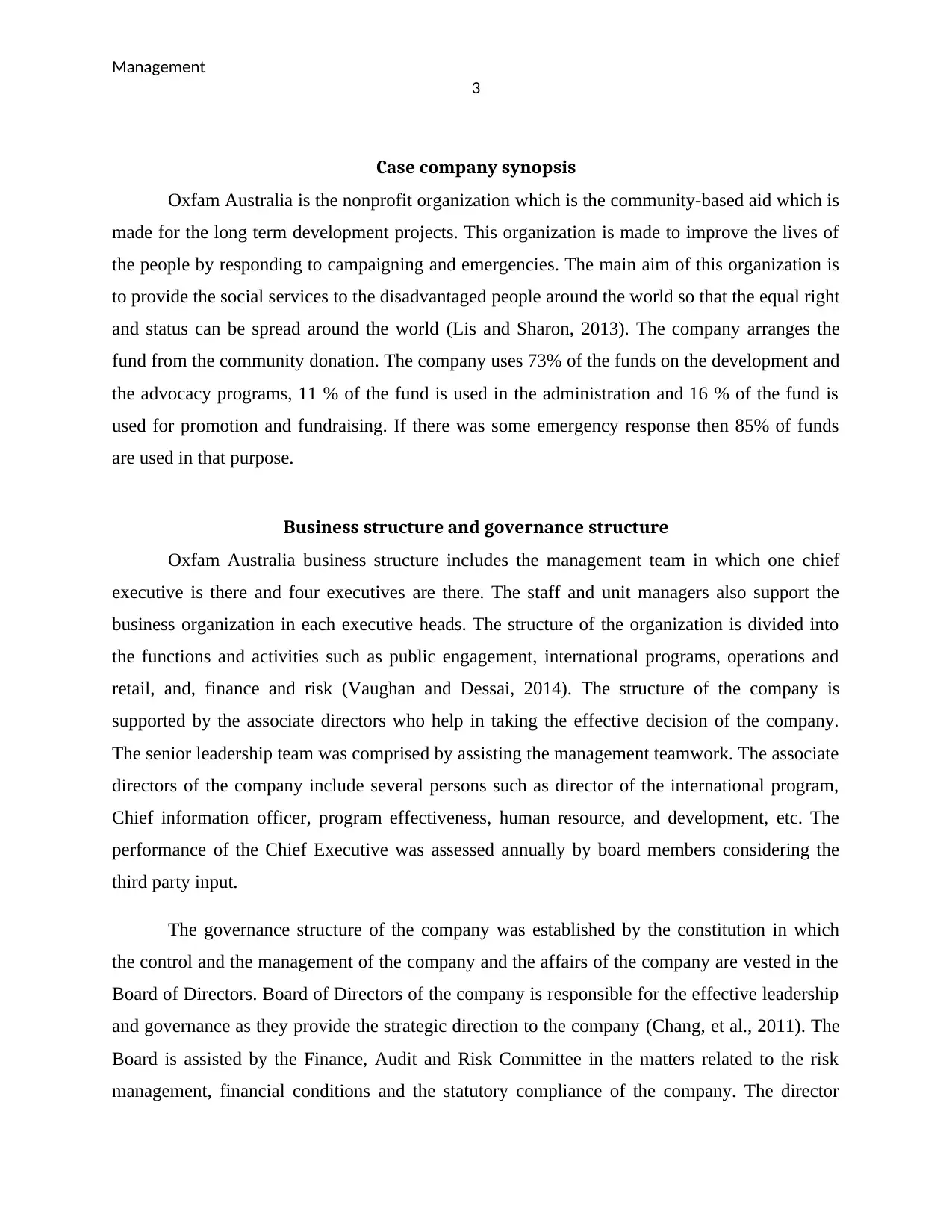
Management
3
Case company synopsis
Oxfam Australia is the nonprofit organization which is the community-based aid which is
made for the long term development projects. This organization is made to improve the lives of
the people by responding to campaigning and emergencies. The main aim of this organization is
to provide the social services to the disadvantaged people around the world so that the equal right
and status can be spread around the world (Lis and Sharon, 2013). The company arranges the
fund from the community donation. The company uses 73% of the funds on the development and
the advocacy programs, 11 % of the fund is used in the administration and 16 % of the fund is
used for promotion and fundraising. If there was some emergency response then 85% of funds
are used in that purpose.
Business structure and governance structure
Oxfam Australia business structure includes the management team in which one chief
executive is there and four executives are there. The staff and unit managers also support the
business organization in each executive heads. The structure of the organization is divided into
the functions and activities such as public engagement, international programs, operations and
retail, and, finance and risk (Vaughan and Dessai, 2014). The structure of the company is
supported by the associate directors who help in taking the effective decision of the company.
The senior leadership team was comprised by assisting the management teamwork. The associate
directors of the company include several persons such as director of the international program,
Chief information officer, program effectiveness, human resource, and development, etc. The
performance of the Chief Executive was assessed annually by board members considering the
third party input.
The governance structure of the company was established by the constitution in which
the control and the management of the company and the affairs of the company are vested in the
Board of Directors. Board of Directors of the company is responsible for the effective leadership
and governance as they provide the strategic direction to the company (Chang, et al., 2011). The
Board is assisted by the Finance, Audit and Risk Committee in the matters related to the risk
management, financial conditions and the statutory compliance of the company. The director
3
Case company synopsis
Oxfam Australia is the nonprofit organization which is the community-based aid which is
made for the long term development projects. This organization is made to improve the lives of
the people by responding to campaigning and emergencies. The main aim of this organization is
to provide the social services to the disadvantaged people around the world so that the equal right
and status can be spread around the world (Lis and Sharon, 2013). The company arranges the
fund from the community donation. The company uses 73% of the funds on the development and
the advocacy programs, 11 % of the fund is used in the administration and 16 % of the fund is
used for promotion and fundraising. If there was some emergency response then 85% of funds
are used in that purpose.
Business structure and governance structure
Oxfam Australia business structure includes the management team in which one chief
executive is there and four executives are there. The staff and unit managers also support the
business organization in each executive heads. The structure of the organization is divided into
the functions and activities such as public engagement, international programs, operations and
retail, and, finance and risk (Vaughan and Dessai, 2014). The structure of the company is
supported by the associate directors who help in taking the effective decision of the company.
The senior leadership team was comprised by assisting the management teamwork. The associate
directors of the company include several persons such as director of the international program,
Chief information officer, program effectiveness, human resource, and development, etc. The
performance of the Chief Executive was assessed annually by board members considering the
third party input.
The governance structure of the company was established by the constitution in which
the control and the management of the company and the affairs of the company are vested in the
Board of Directors. Board of Directors of the company is responsible for the effective leadership
and governance as they provide the strategic direction to the company (Chang, et al., 2011). The
Board is assisted by the Finance, Audit and Risk Committee in the matters related to the risk
management, financial conditions and the statutory compliance of the company. The director
Paraphrase This Document
Need a fresh take? Get an instant paraphrase of this document with our AI Paraphraser
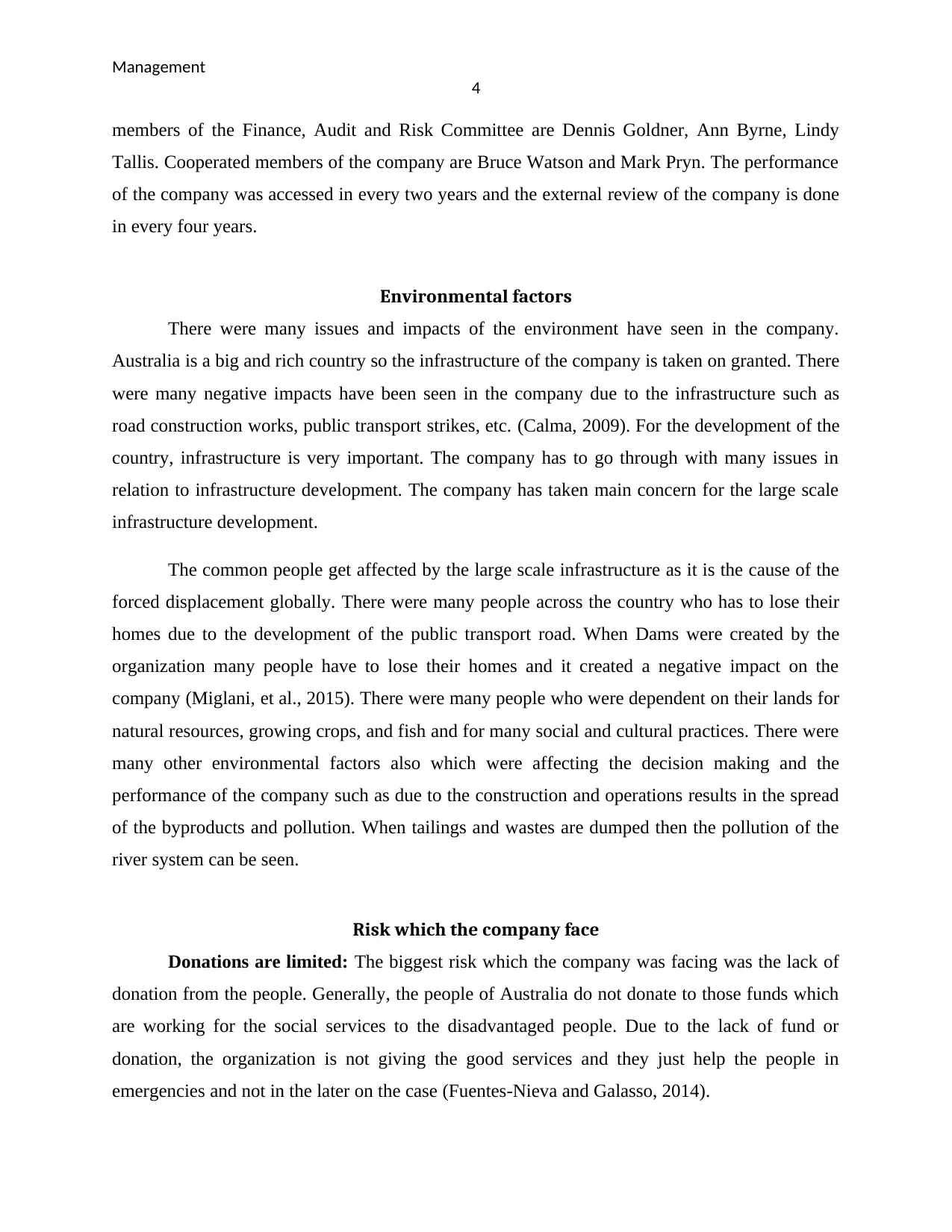
Management
4
members of the Finance, Audit and Risk Committee are Dennis Goldner, Ann Byrne, Lindy
Tallis. Cooperated members of the company are Bruce Watson and Mark Pryn. The performance
of the company was accessed in every two years and the external review of the company is done
in every four years.
Environmental factors
There were many issues and impacts of the environment have seen in the company.
Australia is a big and rich country so the infrastructure of the company is taken on granted. There
were many negative impacts have been seen in the company due to the infrastructure such as
road construction works, public transport strikes, etc. (Calma, 2009). For the development of the
country, infrastructure is very important. The company has to go through with many issues in
relation to infrastructure development. The company has taken main concern for the large scale
infrastructure development.
The common people get affected by the large scale infrastructure as it is the cause of the
forced displacement globally. There were many people across the country who has to lose their
homes due to the development of the public transport road. When Dams were created by the
organization many people have to lose their homes and it created a negative impact on the
company (Miglani, et al., 2015). There were many people who were dependent on their lands for
natural resources, growing crops, and fish and for many social and cultural practices. There were
many other environmental factors also which were affecting the decision making and the
performance of the company such as due to the construction and operations results in the spread
of the byproducts and pollution. When tailings and wastes are dumped then the pollution of the
river system can be seen.
Risk which the company face
Donations are limited: The biggest risk which the company was facing was the lack of
donation from the people. Generally, the people of Australia do not donate to those funds which
are working for the social services to the disadvantaged people. Due to the lack of fund or
donation, the organization is not giving the good services and they just help the people in
emergencies and not in the later on the case (Fuentes-Nieva and Galasso, 2014).
4
members of the Finance, Audit and Risk Committee are Dennis Goldner, Ann Byrne, Lindy
Tallis. Cooperated members of the company are Bruce Watson and Mark Pryn. The performance
of the company was accessed in every two years and the external review of the company is done
in every four years.
Environmental factors
There were many issues and impacts of the environment have seen in the company.
Australia is a big and rich country so the infrastructure of the company is taken on granted. There
were many negative impacts have been seen in the company due to the infrastructure such as
road construction works, public transport strikes, etc. (Calma, 2009). For the development of the
country, infrastructure is very important. The company has to go through with many issues in
relation to infrastructure development. The company has taken main concern for the large scale
infrastructure development.
The common people get affected by the large scale infrastructure as it is the cause of the
forced displacement globally. There were many people across the country who has to lose their
homes due to the development of the public transport road. When Dams were created by the
organization many people have to lose their homes and it created a negative impact on the
company (Miglani, et al., 2015). There were many people who were dependent on their lands for
natural resources, growing crops, and fish and for many social and cultural practices. There were
many other environmental factors also which were affecting the decision making and the
performance of the company such as due to the construction and operations results in the spread
of the byproducts and pollution. When tailings and wastes are dumped then the pollution of the
river system can be seen.
Risk which the company face
Donations are limited: The biggest risk which the company was facing was the lack of
donation from the people. Generally, the people of Australia do not donate to those funds which
are working for the social services to the disadvantaged people. Due to the lack of fund or
donation, the organization is not giving the good services and they just help the people in
emergencies and not in the later on the case (Fuentes-Nieva and Galasso, 2014).
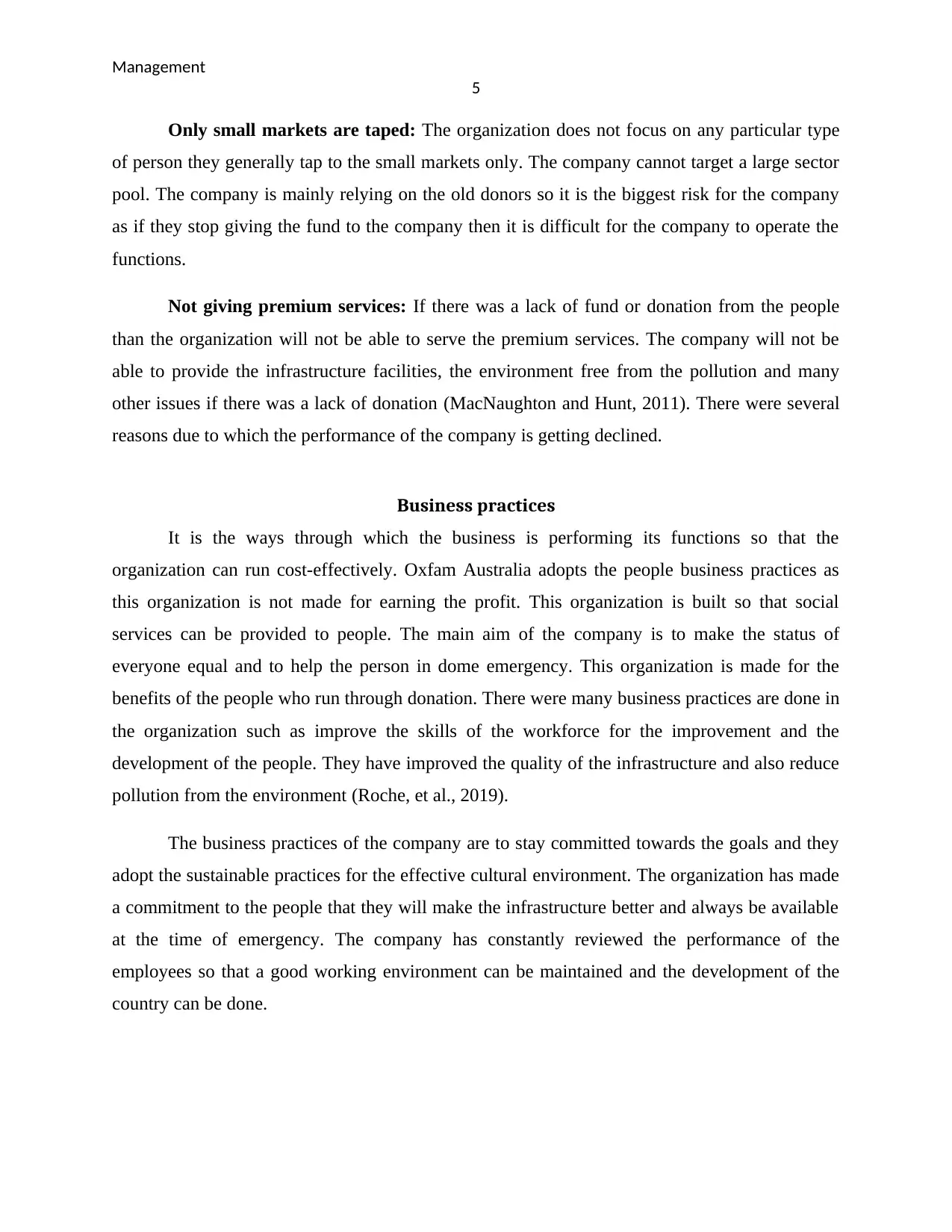
Management
5
Only small markets are taped: The organization does not focus on any particular type
of person they generally tap to the small markets only. The company cannot target a large sector
pool. The company is mainly relying on the old donors so it is the biggest risk for the company
as if they stop giving the fund to the company then it is difficult for the company to operate the
functions.
Not giving premium services: If there was a lack of fund or donation from the people
than the organization will not be able to serve the premium services. The company will not be
able to provide the infrastructure facilities, the environment free from the pollution and many
other issues if there was a lack of donation (MacNaughton and Hunt, 2011). There were several
reasons due to which the performance of the company is getting declined.
Business practices
It is the ways through which the business is performing its functions so that the
organization can run cost-effectively. Oxfam Australia adopts the people business practices as
this organization is not made for earning the profit. This organization is built so that social
services can be provided to people. The main aim of the company is to make the status of
everyone equal and to help the person in dome emergency. This organization is made for the
benefits of the people who run through donation. There were many business practices are done in
the organization such as improve the skills of the workforce for the improvement and the
development of the people. They have improved the quality of the infrastructure and also reduce
pollution from the environment (Roche, et al., 2019).
The business practices of the company are to stay committed towards the goals and they
adopt the sustainable practices for the effective cultural environment. The organization has made
a commitment to the people that they will make the infrastructure better and always be available
at the time of emergency. The company has constantly reviewed the performance of the
employees so that a good working environment can be maintained and the development of the
country can be done.
5
Only small markets are taped: The organization does not focus on any particular type
of person they generally tap to the small markets only. The company cannot target a large sector
pool. The company is mainly relying on the old donors so it is the biggest risk for the company
as if they stop giving the fund to the company then it is difficult for the company to operate the
functions.
Not giving premium services: If there was a lack of fund or donation from the people
than the organization will not be able to serve the premium services. The company will not be
able to provide the infrastructure facilities, the environment free from the pollution and many
other issues if there was a lack of donation (MacNaughton and Hunt, 2011). There were several
reasons due to which the performance of the company is getting declined.
Business practices
It is the ways through which the business is performing its functions so that the
organization can run cost-effectively. Oxfam Australia adopts the people business practices as
this organization is not made for earning the profit. This organization is built so that social
services can be provided to people. The main aim of the company is to make the status of
everyone equal and to help the person in dome emergency. This organization is made for the
benefits of the people who run through donation. There were many business practices are done in
the organization such as improve the skills of the workforce for the improvement and the
development of the people. They have improved the quality of the infrastructure and also reduce
pollution from the environment (Roche, et al., 2019).
The business practices of the company are to stay committed towards the goals and they
adopt the sustainable practices for the effective cultural environment. The organization has made
a commitment to the people that they will make the infrastructure better and always be available
at the time of emergency. The company has constantly reviewed the performance of the
employees so that a good working environment can be maintained and the development of the
country can be done.
⊘ This is a preview!⊘
Do you want full access?
Subscribe today to unlock all pages.

Trusted by 1+ million students worldwide
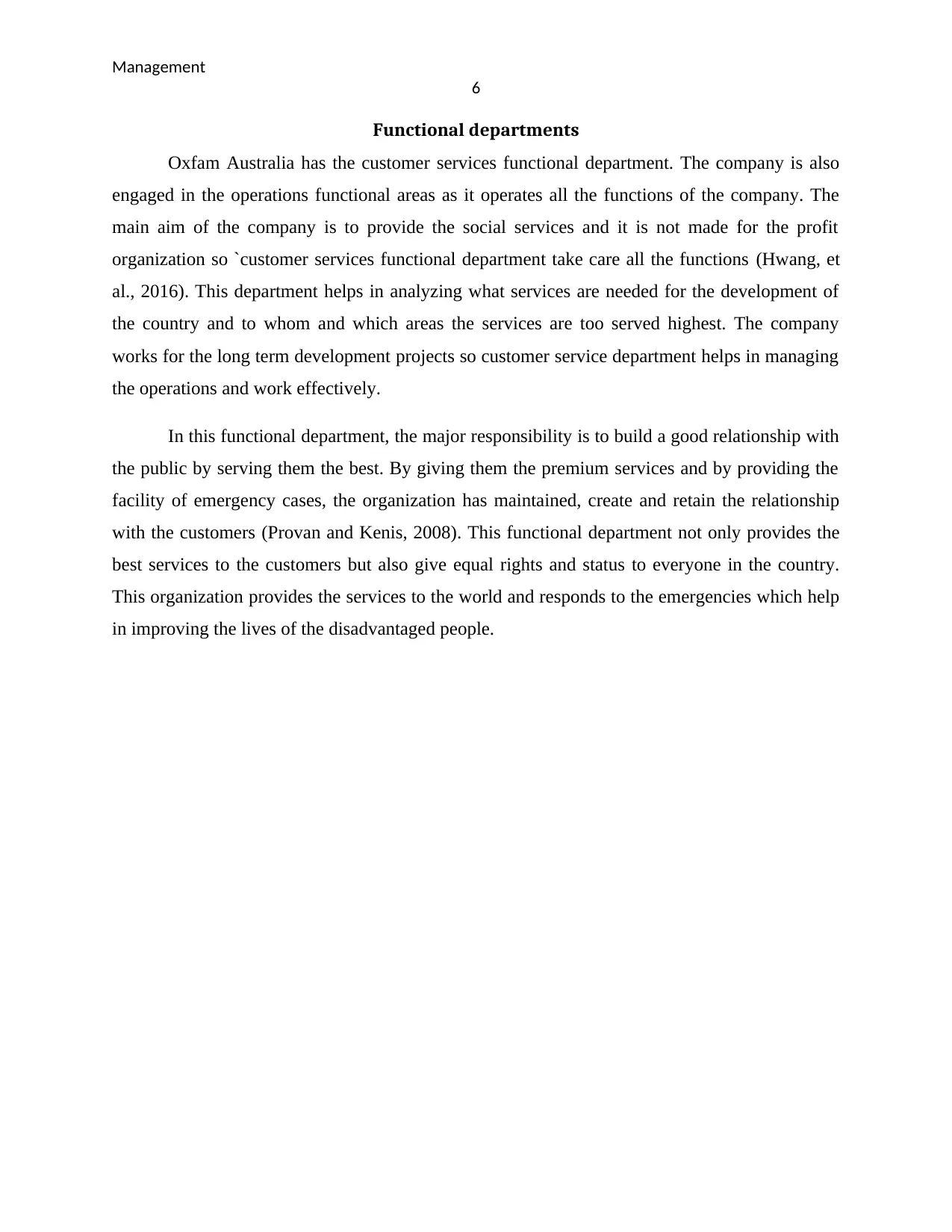
Management
6
Functional departments
Oxfam Australia has the customer services functional department. The company is also
engaged in the operations functional areas as it operates all the functions of the company. The
main aim of the company is to provide the social services and it is not made for the profit
organization so `customer services functional department take care all the functions (Hwang, et
al., 2016). This department helps in analyzing what services are needed for the development of
the country and to whom and which areas the services are too served highest. The company
works for the long term development projects so customer service department helps in managing
the operations and work effectively.
In this functional department, the major responsibility is to build a good relationship with
the public by serving them the best. By giving them the premium services and by providing the
facility of emergency cases, the organization has maintained, create and retain the relationship
with the customers (Provan and Kenis, 2008). This functional department not only provides the
best services to the customers but also give equal rights and status to everyone in the country.
This organization provides the services to the world and responds to the emergencies which help
in improving the lives of the disadvantaged people.
6
Functional departments
Oxfam Australia has the customer services functional department. The company is also
engaged in the operations functional areas as it operates all the functions of the company. The
main aim of the company is to provide the social services and it is not made for the profit
organization so `customer services functional department take care all the functions (Hwang, et
al., 2016). This department helps in analyzing what services are needed for the development of
the country and to whom and which areas the services are too served highest. The company
works for the long term development projects so customer service department helps in managing
the operations and work effectively.
In this functional department, the major responsibility is to build a good relationship with
the public by serving them the best. By giving them the premium services and by providing the
facility of emergency cases, the organization has maintained, create and retain the relationship
with the customers (Provan and Kenis, 2008). This functional department not only provides the
best services to the customers but also give equal rights and status to everyone in the country.
This organization provides the services to the world and responds to the emergencies which help
in improving the lives of the disadvantaged people.
Paraphrase This Document
Need a fresh take? Get an instant paraphrase of this document with our AI Paraphraser
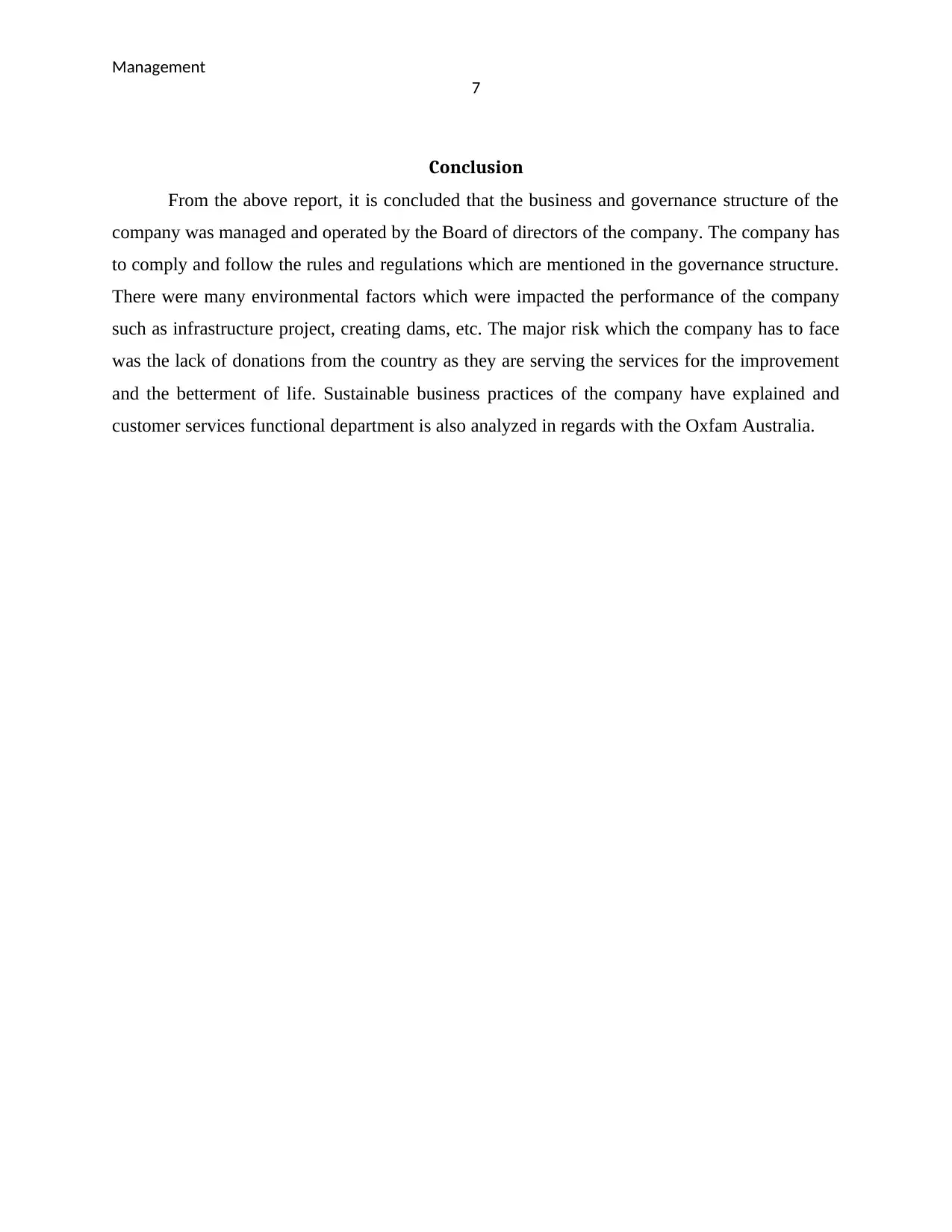
Management
7
Conclusion
From the above report, it is concluded that the business and governance structure of the
company was managed and operated by the Board of directors of the company. The company has
to comply and follow the rules and regulations which are mentioned in the governance structure.
There were many environmental factors which were impacted the performance of the company
such as infrastructure project, creating dams, etc. The major risk which the company has to face
was the lack of donations from the country as they are serving the services for the improvement
and the betterment of life. Sustainable business practices of the company have explained and
customer services functional department is also analyzed in regards with the Oxfam Australia.
7
Conclusion
From the above report, it is concluded that the business and governance structure of the
company was managed and operated by the Board of directors of the company. The company has
to comply and follow the rules and regulations which are mentioned in the governance structure.
There were many environmental factors which were impacted the performance of the company
such as infrastructure project, creating dams, etc. The major risk which the company has to face
was the lack of donations from the country as they are serving the services for the improvement
and the betterment of life. Sustainable business practices of the company have explained and
customer services functional department is also analyzed in regards with the Oxfam Australia.
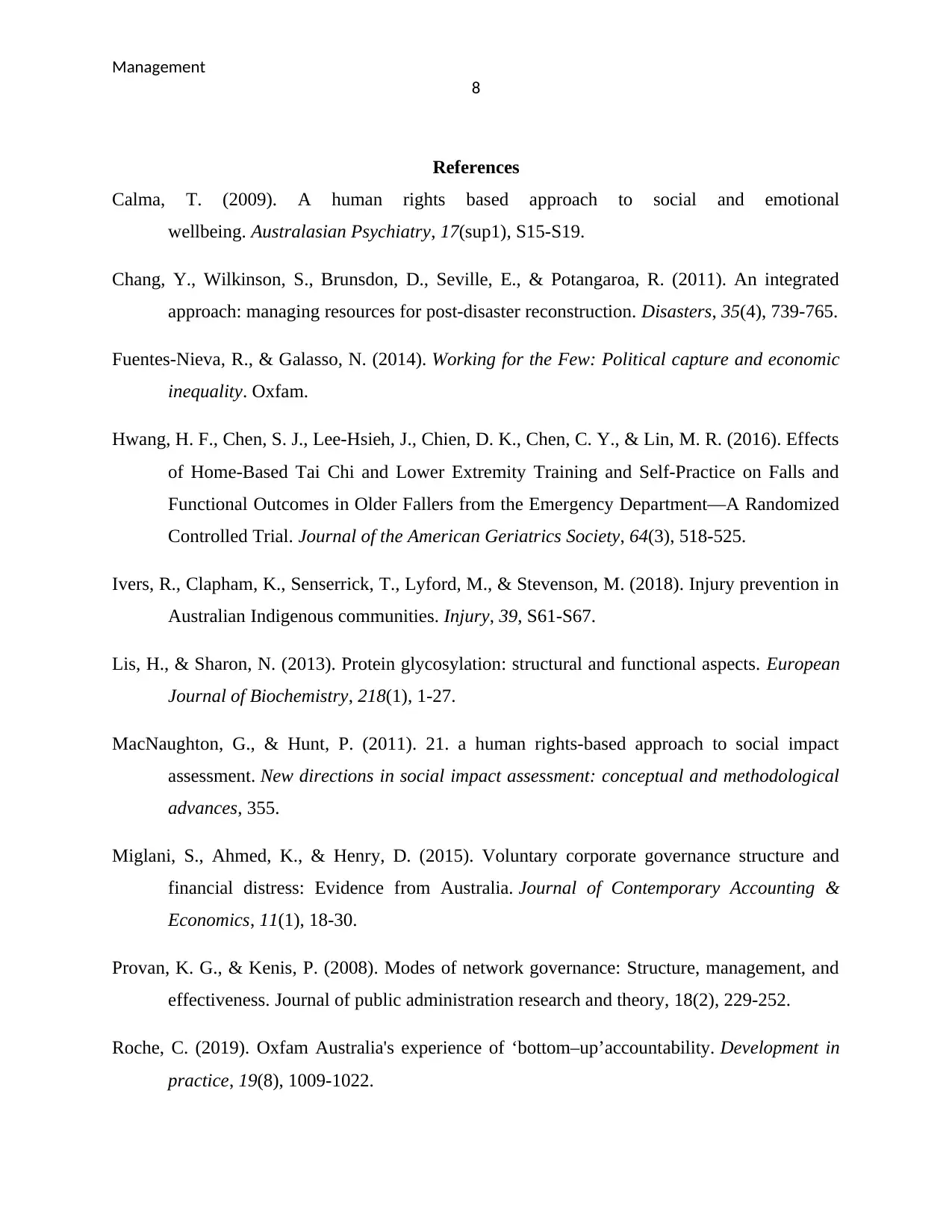
Management
8
References
Calma, T. (2009). A human rights based approach to social and emotional
wellbeing. Australasian Psychiatry, 17(sup1), S15-S19.
Chang, Y., Wilkinson, S., Brunsdon, D., Seville, E., & Potangaroa, R. (2011). An integrated
approach: managing resources for post‐disaster reconstruction. Disasters, 35(4), 739-765.
Fuentes-Nieva, R., & Galasso, N. (2014). Working for the Few: Political capture and economic
inequality. Oxfam.
Hwang, H. F., Chen, S. J., Lee‐Hsieh, J., Chien, D. K., Chen, C. Y., & Lin, M. R. (2016). Effects
of Home‐Based Tai Chi and Lower Extremity Training and Self‐Practice on Falls and
Functional Outcomes in Older Fallers from the Emergency Department—A Randomized
Controlled Trial. Journal of the American Geriatrics Society, 64(3), 518-525.
Ivers, R., Clapham, K., Senserrick, T., Lyford, M., & Stevenson, M. (2018). Injury prevention in
Australian Indigenous communities. Injury, 39, S61-S67.
Lis, H., & Sharon, N. (2013). Protein glycosylation: structural and functional aspects. European
Journal of Biochemistry, 218(1), 1-27.
MacNaughton, G., & Hunt, P. (2011). 21. a human rights-based approach to social impact
assessment. New directions in social impact assessment: conceptual and methodological
advances, 355.
Miglani, S., Ahmed, K., & Henry, D. (2015). Voluntary corporate governance structure and
financial distress: Evidence from Australia. Journal of Contemporary Accounting &
Economics, 11(1), 18-30.
Provan, K. G., & Kenis, P. (2008). Modes of network governance: Structure, management, and
effectiveness. Journal of public administration research and theory, 18(2), 229-252.
Roche, C. (2019). Oxfam Australia's experience of ‘bottom–up’accountability. Development in
practice, 19(8), 1009-1022.
8
References
Calma, T. (2009). A human rights based approach to social and emotional
wellbeing. Australasian Psychiatry, 17(sup1), S15-S19.
Chang, Y., Wilkinson, S., Brunsdon, D., Seville, E., & Potangaroa, R. (2011). An integrated
approach: managing resources for post‐disaster reconstruction. Disasters, 35(4), 739-765.
Fuentes-Nieva, R., & Galasso, N. (2014). Working for the Few: Political capture and economic
inequality. Oxfam.
Hwang, H. F., Chen, S. J., Lee‐Hsieh, J., Chien, D. K., Chen, C. Y., & Lin, M. R. (2016). Effects
of Home‐Based Tai Chi and Lower Extremity Training and Self‐Practice on Falls and
Functional Outcomes in Older Fallers from the Emergency Department—A Randomized
Controlled Trial. Journal of the American Geriatrics Society, 64(3), 518-525.
Ivers, R., Clapham, K., Senserrick, T., Lyford, M., & Stevenson, M. (2018). Injury prevention in
Australian Indigenous communities. Injury, 39, S61-S67.
Lis, H., & Sharon, N. (2013). Protein glycosylation: structural and functional aspects. European
Journal of Biochemistry, 218(1), 1-27.
MacNaughton, G., & Hunt, P. (2011). 21. a human rights-based approach to social impact
assessment. New directions in social impact assessment: conceptual and methodological
advances, 355.
Miglani, S., Ahmed, K., & Henry, D. (2015). Voluntary corporate governance structure and
financial distress: Evidence from Australia. Journal of Contemporary Accounting &
Economics, 11(1), 18-30.
Provan, K. G., & Kenis, P. (2008). Modes of network governance: Structure, management, and
effectiveness. Journal of public administration research and theory, 18(2), 229-252.
Roche, C. (2019). Oxfam Australia's experience of ‘bottom–up’accountability. Development in
practice, 19(8), 1009-1022.
⊘ This is a preview!⊘
Do you want full access?
Subscribe today to unlock all pages.

Trusted by 1+ million students worldwide
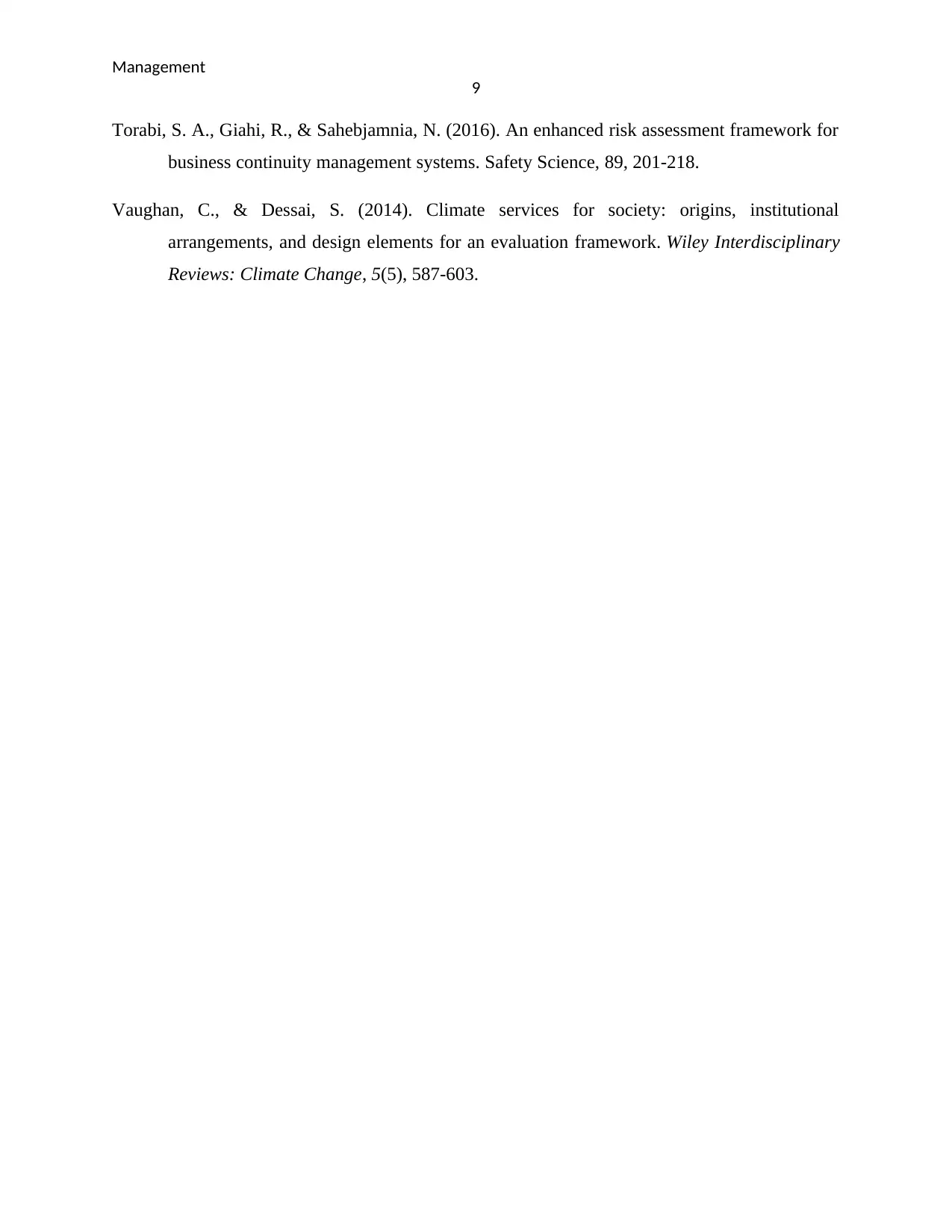
Management
9
Torabi, S. A., Giahi, R., & Sahebjamnia, N. (2016). An enhanced risk assessment framework for
business continuity management systems. Safety Science, 89, 201-218.
Vaughan, C., & Dessai, S. (2014). Climate services for society: origins, institutional
arrangements, and design elements for an evaluation framework. Wiley Interdisciplinary
Reviews: Climate Change, 5(5), 587-603.
9
Torabi, S. A., Giahi, R., & Sahebjamnia, N. (2016). An enhanced risk assessment framework for
business continuity management systems. Safety Science, 89, 201-218.
Vaughan, C., & Dessai, S. (2014). Climate services for society: origins, institutional
arrangements, and design elements for an evaluation framework. Wiley Interdisciplinary
Reviews: Climate Change, 5(5), 587-603.
1 out of 10
Related Documents
Your All-in-One AI-Powered Toolkit for Academic Success.
+13062052269
info@desklib.com
Available 24*7 on WhatsApp / Email
![[object Object]](/_next/static/media/star-bottom.7253800d.svg)
Unlock your academic potential
Copyright © 2020–2025 A2Z Services. All Rights Reserved. Developed and managed by ZUCOL.



